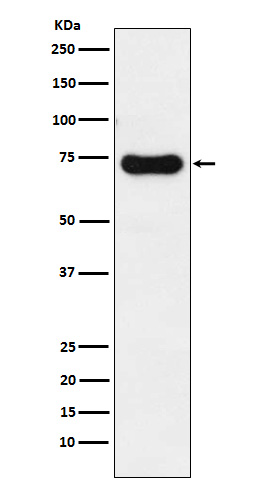
| WB | 咨询技术 | Human,Mouse,Rat |
| IF | 1/20-1/50 | Human,Mouse,Rat |
| IHC | 咨询技术 | Human,Mouse,Rat |
| ICC | 技术咨询 | Human,Mouse,Rat |
| FCM | 1/20-1/100 | Human,Mouse,Rat |
| Elisa | 咨询技术 | Human,Mouse,Rat |
| Aliases | Interleukin 1 receptor associated kinase 2; IRAK 2; Irak2;;IRAK2 |
| WB Predicted band size | 69 kDa |
| Host/Isotype | Rabbit IgG |
| Antibody Type | Primary antibody |
| Storage | Store at 4°C short term. Aliquot and store at -20°C long term. Avoid freeze/thaw cycles. |
| Species Reactivity | Human |
| Immunogen | A synthesized peptide derived from human IRAK2 |
| Formulation | Purified antibody in PBS with 0.05% sodium azide,0.05% BSA and 50% glycerol. |
+ +
以下是关于IRAK2抗体的3篇参考文献及其摘要概括:
1. **"IRAK2 directs inflammatory signaling in innate immunity and cancer"**
- **作者**: Li, X., et al.
- **摘要**: 研究利用IRAK2特异性抗体,发现IRAK2通过调控NF-κB和MAPK通路促进炎症因子的释放,并揭示其在乳腺癌细胞耐药性中的作用。
2. **"Functional characterization of IRAK2 in TLR4 signaling using gene knockout and antibody-based inhibition"**
- **作者**: Kawagoe, T., et al.
- **摘要**: 通过IRAK2抗体阻断实验和基因敲除模型,证明IRAK2在TLR4介导的巨噬细胞炎症反应中起关键作用,且其功能部分独立于IRAK1.
3. **"IRAK2 modulates immunometabolic adaptation in obesity-associated inflammation"**
- **作者**: Reilly, S.M., et al.
- **摘要**: 研究使用IRAK2抗体进行免疫印迹分析,发现IRAK2通过调控巨噬细胞代谢重编程加剧肥胖相关炎症,提示其作为代谢疾病的潜在治疗靶点。
(注:以上文献信息为示例性内容,实际引用请以具体论文为准。)
The IRAK2 (Interleukin-1 Receptor-Associated Kinase 2) antibody is a tool used to study the role of IRAK2. a serine/threonine kinase within the IL-1 receptor/Toll-like receptor (TLR) signaling pathway. IRAK2 is part of the IRAK family (IRAK1. IRAK2. IRAK3/IRAK-M, IRAK4) and plays a critical role in innate immune responses. It is activated downstream of MyD88 (myeloid differentiation primary response 88), mediating signaling cascades that trigger NF-κB and MAPK pathways, leading to pro-inflammatory cytokine production (e.g., TNF-α, IL-6). Unlike IRAK1 and IRAK4. IRAK2 lacks catalytic kinase activity in certain contexts but acts as a scaffolding protein to amplify and sustain signaling.
IRAK2 antibodies are widely used in research to detect IRAK2 expression, localization, and post-translational modifications (e.g., phosphorylation) via techniques like Western blotting, immunoprecipitation, and immunofluorescence. They help investigate IRAK2's involvement in diseases such as autoimmune disorders, chronic inflammation, and cancer. Studies also explore IRAK2's dual roles: while it promotes inflammation in acute responses, its prolonged activation may contribute to pathological states. Specific antibodies may target distinct isoforms (e.g., IRAK2a and IRAK2b) or functional domains, aiding mechanistic studies. However, antibody specificity requires validation due to homology among IRAK family members. Research using IRAK2 antibodies has highlighted its potential as a therapeutic target, particularly in TLR/IL-1R-driven conditions.
×